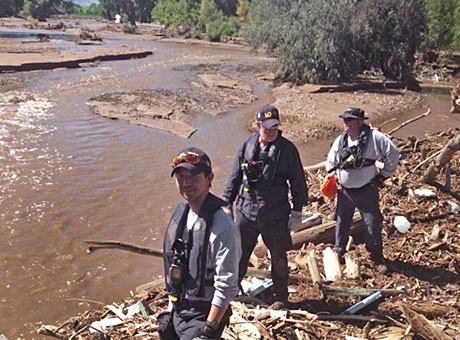

Stephen Liang, MD, instructor of medicine, recently spent nine days in Colorado treating fellow crew members from Missouri Task Force 1 and those impacted by the flood.
Founded after the Oklahoma City bombings, Missouri Task Force 1 (MO-TF1) is one of 28 FEMA urban search and rescue task forces in the country. Sponsored by Boone County Fire Protection District in Columbia, the task force includes rescue workers from across the state. It has carried out missions at Ground Zero, Hurricane Katrina and other disaster sites nationwide.
On Sept. 16, the unit deployed to Colorado, where catastrophic flooding has resulted in eight deaths, affected 20 counties and damaged or destroyed nearly 20,000 homes, 200 miles of highways and 50 bridges.
About 80 specially trained first responders from Missouri traveled to the Rocky Mountain foothills, establishing a base of operations at Larimer County Fairgrounds. Covering treacherous terrain, the unit searched for victims, made thousands of rescues and provided aid.
Liang, who has a dual appointment in emergency medicine and infectious diseases at the School of Medicine, served as one of two physician medical team managers and oversaw a group of paramedics.
While there, he treated MO-TF1 team members suffering from dehydration, musculoskeletal injuries, bee stings and other aches and pains sustained in the field. He also worked in an evacuee medical evaluation and treatment tent as residents were airlifted from mountain towns cut off by the flood.
Search and rescue
Colorado marked the first disaster experience for Liang, who joined MO-TF1 in 2011. As part of the relief effort, Liang participated in helicopter evacuations at Storm Mountain, went door to door searching for missing persons around Estes Park, and combed debris piles for human remains and other hazards.
Along the flood zone, he encountered swift water and quicksand-like mud. “One of our members sank almost waist-deep into mud and was a challenge to extricate,” Liang said. “Other unexpected scenarios included mountain communities where people didn’t necessarily want contact with the federal government. We traveled with Larimer County sheriffs because some of these individuals had met other visitors on their property with firearms.”
By and large, however, most people expressed sincere gratitude as the unit’s 17-vehicle convoy pulled into rest stops along the way. “These residents who had lost so much during the floods, they thanked us for taking time away from our own families to help theirs. It was humbling.”
Back at home, Liang’s family — his wife, Philana, AB ’96 (who also works in the Division of Infectious Diseases as a physician assistant), a new baby girl and three other children — watched and waited. “Our household is a bustling place,” Liang said. “Email, phone and Skype were wonderful ways to stay in touch, although I could always hear the chaos at home and felt guilty for being away.
“Our oldest son, who is almost 6, saw footage of the Colorado floods on the news and was worried about my safety, that I would get swept away by the water.”
The impact of 9/11
Liang’s interest in disaster relief began with 9/11. At the time, he was a second-year medical student at the University of Maryland; his brother lived five blocks from the World Trade Center. Two weeks following the attacks, Liang walked through Ground Zero. From the other side of the fence, he watched as emergency crews worked around the clock to find survivors.
Years later, he learned that many of the men and women assisting the effort were volunteers from various urban search and rescue teams, including MO-TF1.
“I would see the same teams deployed to disasters such as Hurricane Katrina,” Liang said. “I wanted to contribute to their work, so when I became a board-certified emergency physician, I volunteered.”
Out of the comfort zone
Although Liang served as an emergency medical technician through college and enjoys hands-on work in the pre-hospital setting, he admits that joining MO-TF1 took him out of his comfort zone.
All MO-TF1 members, regardless of specialty, go through structural collapse technician training. There, they learn about rigging, rappelling, shoring and busting through concrete with heavy machinery. They also train in self-contained breathing apparatus, chemical/biological/radiological/nuclear threats, hazardous materials operations and water rescue.
MO-TF1 annually stages an operational readiness exercise, which sometimes includes mass casualty scenarios and time spent in the “pile” (a training facility of concrete rubble, smashed cars and narrow underground tunnels simulating a collapsed building).
Despite the risks he faced in Colorado, Liang insists he played a small role. “The focus really should be on the firefighters, paramedics, search/rescue specialists, K-9 specialists, engineers and logistics coordinators. I was there so that they could do their jobs and know that medical help was close by if they needed it.”
The support of colleagues
Liang also credits his division chiefs — William Powderly, MD, Brent Ruoff, MD, and Victoria Fraser, MD — for enabling him to train and serve with MO-TF1. On less than 24 hours notice, Jeffrey Henderson, MD, PhD, agreed to cover Liang’s clinical commitments at Barnes-Jewish Hospital. Many of the faculty in infectious diseases and emergency medicine are engaged in international outreach and disaster efforts.
Liang, now back in his “routine,” shares his biggest takeaway: “You can always make a difference. Be open, be prepared and be willing to step up when the call arises, whether it is in your daily work in the hospital, hearing the overhead page for a physician on a plane, coming across a wreck on the highway, or in the midst of a disaster,” said Liang, who, at age 10, lost his own father in a car crash.
“It is a privilege and an honor to serve others through the medical profession. Don’t forget that. And don’t ever take it for granted. If I was hurt, lost, or entrapped, I’d hope someone else would step up and come to my aid.”